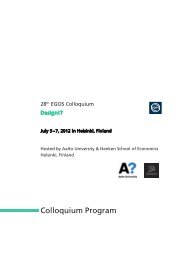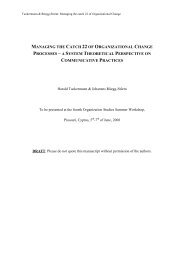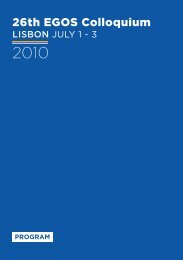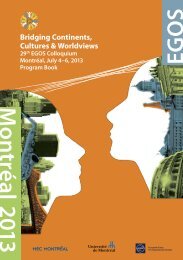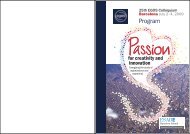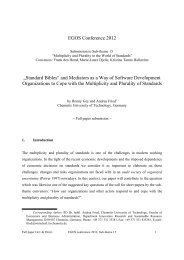A single set of standards and the multiplicity of interpretations - EGOS
A single set of standards and the multiplicity of interpretations - EGOS
A single set of standards and the multiplicity of interpretations - EGOS
Create successful ePaper yourself
Turn your PDF publications into a flip-book with our unique Google optimized e-Paper software.
2. A translation <strong>the</strong>ory approach to international accounting regulation<br />
2.1 Theoretical insights on translation, translatability <strong>and</strong> terminology<br />
“Linguistically naïve persons tend to think <strong>of</strong> translation as a text which is a sort <strong>of</strong> ‘reproduction’ <strong>of</strong> a<br />
text originally produced in ano<strong>the</strong>r language, where this reproduction is somehow <strong>of</strong> comparable value.”<br />
Juliane House (2006), translation <strong>the</strong>orist<br />
Whe<strong>the</strong>r it is possible to translate a text into ano<strong>the</strong>r language is a question that has been<br />
pondered upon by linguists <strong>and</strong> philosophers for centuries. On a practical level, we can conclude<br />
that at least some dimensions <strong>of</strong> translatability are achieved as texts have been <strong>and</strong> are translated<br />
from one language (“source language”) into ano<strong>the</strong>r language (“target language”) but <strong>of</strong>ten <strong>the</strong><br />
translated text cannot convey all <strong>the</strong> nuances <strong>of</strong> meaning in <strong>the</strong> original text (Chesterman 2000,<br />
8-11).<br />
The <strong>the</strong>oretical part <strong>of</strong> this study draws on <strong>the</strong> field <strong>of</strong> translation studies by borrowing selected<br />
notions which are refined with concepts from terminology for describing overall issues that make<br />
any translation a complex task: Translation <strong>the</strong>orists have analyzed translatability <strong>and</strong> translations<br />
with <strong>the</strong> concept <strong>of</strong> equivalence (Pym 2007, Chesterman 2000, 9-10, Reiss <strong>and</strong> Vermeer 1986,<br />
60). In general, equivalence refers to <strong>the</strong> relationship between <strong>the</strong> source text (or a part <strong>of</strong> it) <strong>and</strong><br />
<strong>the</strong> target language text (or a part <strong>of</strong> it), <strong>and</strong> <strong>the</strong>re is a body <strong>of</strong> literature in translation studies that<br />
conceptualizes various types <strong>of</strong> equivalence: for instance Nida (1964) makes a dichotomous<br />
distinction between formal equivalence (i.e. focusing on <strong>the</strong> same form) <strong>and</strong> dynamic equivalence<br />
(conveying <strong>the</strong> thought expressed in <strong>the</strong> source text at <strong>the</strong> expense <strong>of</strong> literality). Formal <strong>and</strong><br />
dynamic equivalence represent somewhat opposite approaches to which dimensions <strong>of</strong><br />
equivalence are or should be given <strong>the</strong> priority in translation when perfect correspondence in<br />
form <strong>and</strong> meaning does not exist between different languages. (See also Evans et al. 2011.)<br />
When full equivalence between concepts in two languages does not exist, translation studies<br />
identify following solutions to compensate <strong>the</strong> lack <strong>of</strong> equivalence between <strong>the</strong> concept systems:<br />
First, <strong>the</strong> translator can use definitions to describe what <strong>the</strong> source language word means.<br />
However, this is nei<strong>the</strong>r allowed by IASB in <strong>the</strong> translation <strong>of</strong> IFRS (IASB, Terms <strong>of</strong> Reference)<br />
nor according to EU’s translation policies. Second, <strong>the</strong> translator can translate literally term<br />
consisting <strong>of</strong> multiple words e.g. true <strong>and</strong> fair view (cf. e.g. Aisbitt & Nobes 2001). The problem<br />
5



